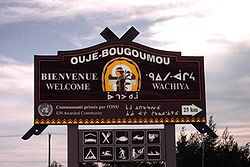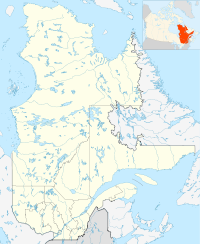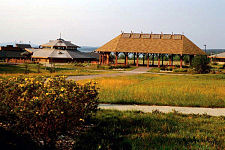- Oujé-Bougoumou, Quebec
-
Coordinates: 49°55′N 74°49′W / 49.917°N 74.817°W
Oujé-Bougoumou Motto: The Place Where People Gather Coordinates: 49°55′24″N 74°49′14″W / 49.92333°N 74.82056°W Country  Canada
CanadaProvince  Quebec
QuebecRegion Nord-du-Québec Government – Chief Louise Wapachee Area[1] – Total 2.54 km2 (1 sq mi) Elevation[citation needed] 372 m (1,220 ft) Population (2006)[1] – Total 606 – Density 238.4/km2 (617.5/sq mi) Time zone EST (UTC−5) – Summer (DST) EDT (UTC−4) Postal Code G0W Area code(s) 418 Website www.ouje.ca Oujé-Bougoumou (Cree: ᐆᒉᐳᑯᒨ ûcêpukumû, akin to name of the nearby town Chibougamau, the meaning of which has been lost) is the newest Cree community located on the shores of Lake Opemisca, in the Jamésie region of Quebec, Canada. It has a population of 606 people (Canada 2006 Census).
Oujé-Bougoumou (referred to as "Oujé" by local residents) is accessible by a 25 kilometres (16 mi) paved road (gravel before 2008), linking to Route 113 not far from Chapais. Along with the neighbouring towns of Chibougamau and Chapais, Oujé-Bougoumou is serviced by the Chibougamau/Chapais airport located approximately 42 kilometres (26 mi) away on Route 113.
Contents
History
The Cree in the Chibougamau area had been marginalized in the 20th century by many forced relocations. After decades of relocations, this band gained recognition by the government and was given land to construct a new permanent village. It was designed by architect Douglas Cardinal (famous for the Canadian Museum of Civilization in Gatineau, Quebec) and was built in 1992. It has won recognition and awards for its modern concepts combining economic sustainability, environmental conservation, and design.[2][citation needed]
Education
While a majority of the youth attend the English and Cree immersion school, Waapihtiiwewan School, operating in Oujé-Bougoumou, some families elect to send their children to French schools in the nearby towns instead.
A cultural institute named Aanischaaukamikw is in construction, official opening is set for November 11, 2011 (11-11-11). The name Aanischaaukamikw (âniscewikamikw in the southern dialect) translated into English conveys the meaning "heritage center" (âniscew-, meaning 'ancestry' + -kamikw, meaning 'room' or 'building'). It is to be developed into a multi-purpose cultural institution with the purpose of bringing cultural programs of the region together by adapting and including the programs currently offered by the James Bay Cree Cultural Education Center and those of the Cree Regional Authority.
The Aanischaaukamikw institute will also have the task of collaborating on the research of the Cree language currently undertaken by the Cree School Board.[3]
Leisure
In addition to the local Petaapin Youth Center, there is also a sports complex hosting a swimming pool, a competition grade ice rink, and weight training facilities. Just outside the village lies a motocross course that can be converted to a snocross course in the winter.
Economy
The economy of Oujé-Bougoumou is focused mainly in mining exploration, trapping, tourism, construction, outfitters, and the cultivation of blueberry farms.[4]
On November 9, 2009 under the Canadian Economic Action Plan, it was announced that a combined sum of $3.2 million will invested into the development of the Aanischaaukamikw Cultural Institute. The funding would be allocated from the budgets of the Department of Canadian Heritage, the Canada Economic Development Agency, and Indian and Northern Affairs Canada.[5]
Innovation
Being a relatively new community, the planners for the community were able to look into new ideas for urban development. Using examples of teleheating in certain urban areas, the planners decided to implement a community wide district heating system. The heating for the village is produced in a central boiler house. The boiler house is equipped with two boilers. One boiler has duel fuel capabilities, both wood and oil, and the second boiler for peaking and standby oil firing only.
The wood-fired boiler is fully automatic from fuel in-feed to ash removal. The system has built-in telecommunications modem for remote troubleshooting and supervision. The wood supply is actually a by-product from the nearby sawmills that would normally be considered as waste. If the wood supply becomes limited due to severe weather conditions, the boiler can be operated on oil.
From the boiler house, the heat is piped via an underground hot water distribution network with supply and return pipelines in a closed circuit. Each building is connected to the network via a customer heat transfer station that regulates and measures the energy taken from the distribution system. Each building is directly connected to the distribution system. From there each building gets a supply of hot water and in cooler weather, heating.[6]
References
- ^ a b Statistics Canada Census 2006 - Oujé-Bougoumou community profile
- ^ http://www.provincequebec.com/first-nations/ouje-bougoumou/
- ^ http://www.creeculture.ca/e/institute/what.html
- ^ http://www.ainc-inac.gc.ca/ai/scr/qc/aqc/prof/Ouje-eng.asp
- ^ http://www.dec-ced.gc.ca/eng/media-room/news-releases/2009/11/2227.html
- ^ http://www.ouje.ca/content/our-story/innovation.php
External links
Grand Council of the Crees Chisasibi · Eastmain · Mistissini · Nemaska · Oujé-Bougoumou · Waskaganish · Waswanipi · Wemindji · WhapmagoostuiCategories:- Cree villages in Quebec
- Eeyou Istchee
Wikimedia Foundation. 2010.



